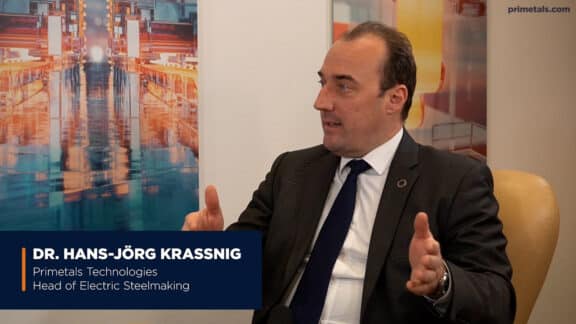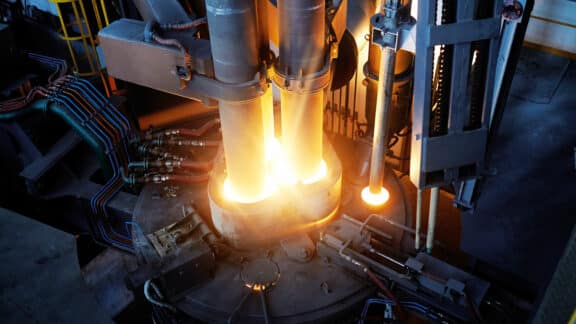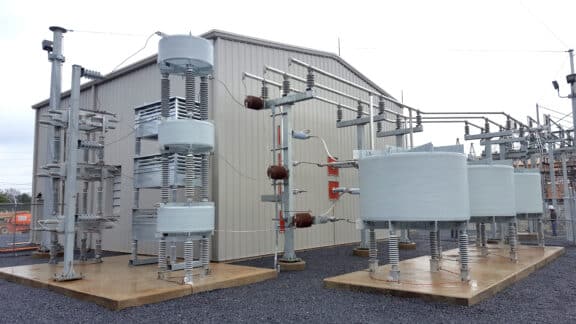A changing electrical grid landscape presents steel producers utilizing an electric arc furnace with new challenges and standards regarding performance and grid stability. For renewable energy systems and producers looking for increased efficiency, from electricity savings to lower electrode consumption, Primetals Technologies created the Active Power Feeder.
For the energy sector, chemical, steel, and cement industries account for half of industrial energy use and around 70 percent of direct carbon emissions from the energy sector. According to the International Energy Agency and the Sustainable Development Scenario, the iron and steel industry will experience fundamental shifts toward increased use of direct reduction and the electrification of steel production. Translated to global steel production by 2070, the electric arc furnace will make up 74 percent of all steel production in this scenario. However, with the expansion of electric arc furnace adoption and application worldwide, producers must adapt to increased regulations and various grid types to maintain high-performance levels in the electrical grid.
Renewable Energy Grids
With an increase in the global economy heading toward 2050, global energy consumption is predicted to grow by 30 percent. Simultaneously, funding is pushing for increased adoption, application, and expansion of renewable energy sources to reduce the negative environmental impact of the energy sector. While hydroelectric power is the most widely used renewable energy source, wind and solar energy are expanding. However, renewable energy sources present a high level of uncertainty, dependent upon weather conditions or specific geographic locations, and are subject to power imbalances and supply-demand mismatches.
As pressure builds to achieve sustainable steel production, producers are shifting increasingly toward electrification. Currently, steel production accounts for 20 percent of electricity consumption in Europe. With new high-capacity and energy-efficient electric arc furnaces emerging, conventional steel production is transforming. However, these new furnaces must meet grid requirements to maintain power quality and stability, especially as renewable energy-based grids become increasingly prevalent. Primetals Technologies has developed the Active Power Feeder precisely to support metals producers with new installation and modernization of electric arc furnaces.
Equipment
- Compensation, furnace breaker, series reactor are not needed
- Flexible installation outside furnace building
- Proven modular multilevel converter
Grid
- Low flicker and harmonic generation, cos phi close to 1
- AC furnace operation on a very weak electrical network
- Possibility to compensate a ladle furnace
Process
- Increased arc stability
- Increase active power with highly dynamic current control
- Reduced power-on time and losses
- Increased productivity
- Reduced electrode consumption
Maintenance
- Reduced stress and wear on electrical and mechanical equipment
- Reduced maintenance
Raising the Bar
The conventional operation of an electric arc furnace melting scrap utilizes a stepdown transformer, a vacuum circuit breaker, a series reactor, a furnace transformer, a secondary high current system, and graphite electrodes. A Static Var Compensator (SVC) or Static Synchronous Compensator (STATCOM) helps minimize network disturbances and maintain close-to-unity power factors that comply with quality requirements. Despite these various operational elements, the dynamic behavior of the electric arc leads to strong fluctuations in the current, and they are significantly faster than the control speed of the electro-mechanical positioning system of the electrodes.

Conventional furnace
- Slow electromechanical actuators
- Separate compensation system is mandatory
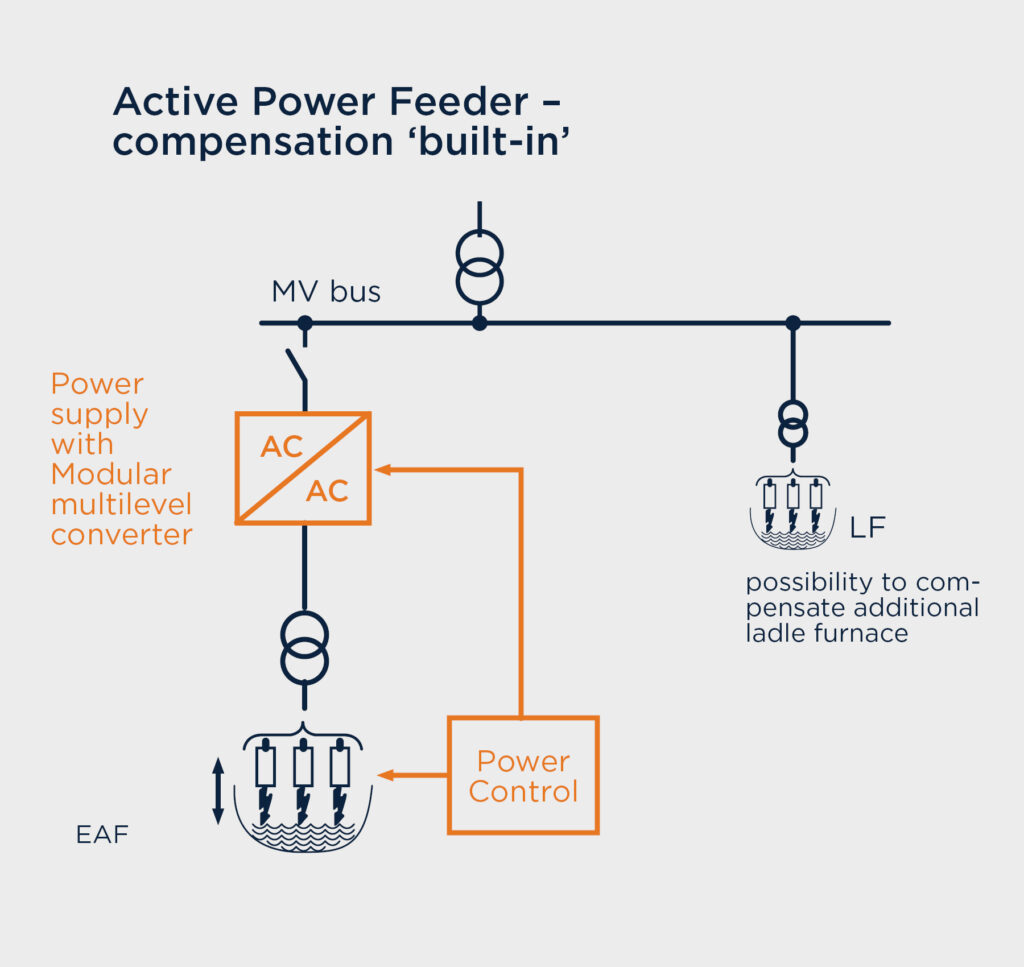
Active Power Feeder
- Compensation “built-in”
- Fast, stepless current control with converter
- Possibility to compensate additional ladle furnace, “built-in”
Thus, Primetals Technologies sought to design and implement an electronic power supply device to provide fast current control, current limitation, line-side balanced power, low flicker generation, and low harmonics while simultaneously offering flexibility in installation and inherent redundancy and fail-safes for the power converter to guarantee continuous furnace operation. Specialists examined the requirements and concluded that if the power supply has the additional function of controlling the grid side with an “Active Front-End”—to control flicker and harmonics and to provide reactive compensation power for a parallel ladle furnace— the furnace does not require compensation equipment, e.g., an SVC, STATCOM, or filter circuits.
Active Power Feeder
The Active Power Feeder utilizes a high-speed electronic actuator, a modular multilevel converter, to supply balanced power from the supplying medium voltage bus to the electric arc furnace in the most “grid-friendly” way. The modular multilevel converter design allows low electrical losses, low harmonic distortion, and perfect voltage and current shapes. These features are necessary to achieve high power quality without additional compensation systems. The change of frequency is possible in addition. A higher frequency—e.g., 60 Hz—increases arc stability during the boring and melting phases. A lower frequency—e.g., 40 Hz—decreases electrical losses in the refining phase. The furnace transformer can be simplified as well. The new transformer also drastically reduces the amount of on-load tap changes. In addition, the converter limits the amount of short circuit current to the transformer, so the transformer does not need to be short circuit proof.
The converter efficiently decouples the grid and the furnace and controls both individually, minimizing the negative impacts of the furnace on the grid. Ensuring a high power factor, low harmonic distortions, low flicker values, and a close-to-unity power factor. The results are a flicker reduction factor better than a STATCOM, the dirty furnace bus becomes a clean bus, and an additional load like a ladle furnace can be compensated.
Combining Competencies and Systems
The modular multilevel converter is the ideal new actuator to realize new advanced furnace control concepts. The new actuator operates stepless, and furnace working points can be modified quickly according to the process condition. The converter combines with Melt Expert’s new intelligent subordinate power control concept. Arc length and arc voltage are actuated with the electrode arm hydraulic system. Melt Expert also provides the setpoints for the converter, i.e., current setpoint and frequency setpoint. Setpoints can be actuated individually for each phase and electrode to correct thermal imbalance in the furnace. Melt Expert features stored meltdown profiles for the different process phases, including the boring, meltdown, and flat bath phases. These profiles activate depending on the steel grade and the meltdown process conditions.
Improvement and Potential
Utilizing digital twin simulations, experts at Primetals Technologies have explored the potential of Active Power Feeder with actual furnace data, particularly on savings in the Power-on time and electrode tip burn-off. While savings vary depending on the specific plant’s operational parameters and material mix, the savings are apparent. In the simulation example, the Active Power Feeder minimized current fluctuation and actively limits over-current due to short -circuits. By controlling the converter output voltage, the reaction of the control in the event of disturbances is way faster than by changing the electrodes with the hydraulic system. With the Active Power Feeder, the on-load tap charger of the furnace transformer actuates only once when changing from the melting phase into the refining phase to increase the currents.
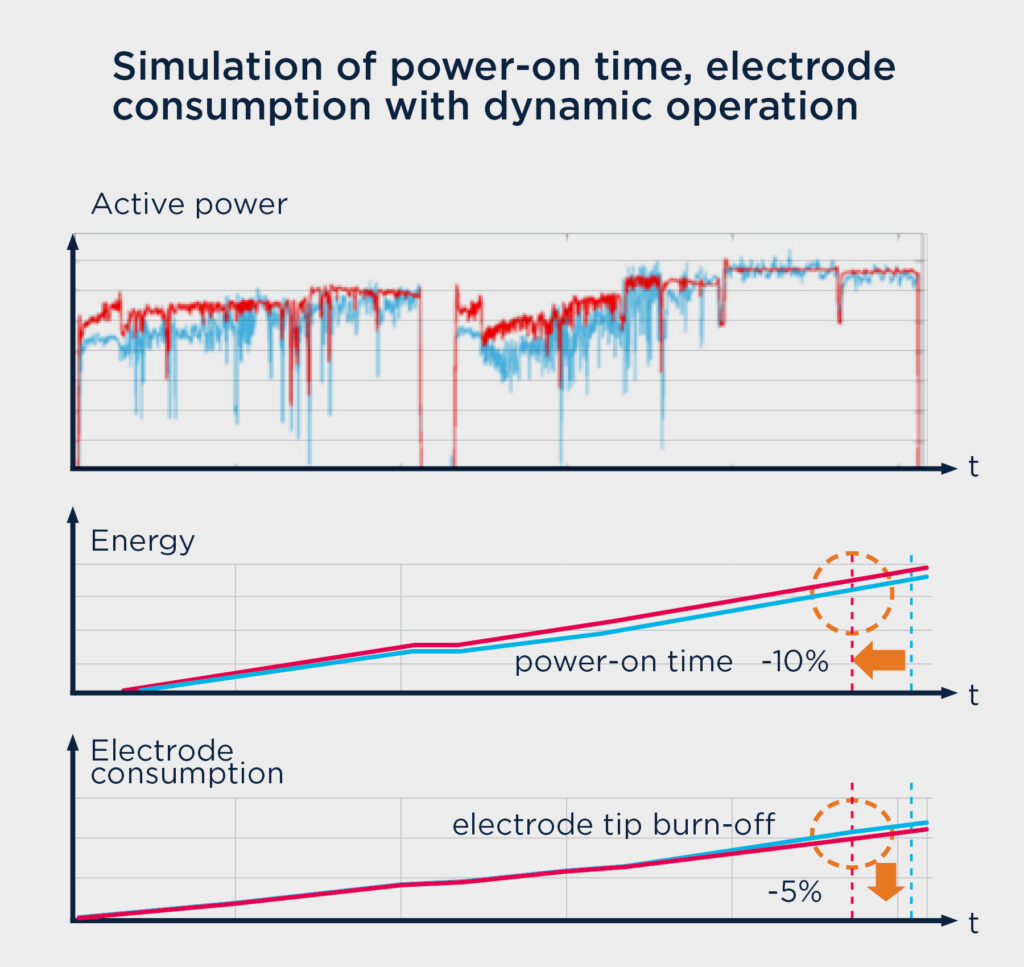
In this scenario, the actual power input into the furnace can increase in the boring and melting phase. Higher power input reduces power on time by ten percent in the simulation example, meaning it also reduces thermal losses and electrical energy use and provides the possibility of increasing production. Moreover, electrode tip consumption is reduced by 5 percent in the simulation example. Further potentials were also explored in the digital twin simulation, including reduced energy consumption in the refining phase by lowering the converter’s output frequency to 40Hz or lower. Side benefits include reduced mechanical and electrical equipment stress through controlled furnace currents and reduced wear and maintenance.
Balancing Power
Active Power Feeder is a straightforward solution that offers benefits over conventional furnace operation and conventional compensation systems such as SVC or STATCOM. As its name suggests, the Active Power Feeder actively feeds the electric arc furnace, minimizing perturbations caused by the furnace to the grid without needing an additional compensation system. The Active Power Feeder marks a shift in how electric arc furnaces will be powered and operated with increased production and reduced operational and maintenance costs. Green steel and electric steelmaking in the future demand high power quality, and the Active Power Feeder is here to revolutionize the industry.
